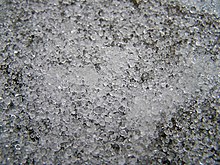Begin quote from:
ice pellets (American sleet),
Ice pellets
precipitation consisting of small, translucent balls of ice. Ice pellets are smaller than hailstones[1] which form in thunderstorms rather than in winter, and are different from graupel ("soft hail") which is made of frosty white rime, and from a mixture of rain and snow which is a slushy
liquid or semisolid. Ice pellets often bounce when they hit the ground
or other solid objects, and make a higher-pitched "tap" when striking
objects like jackets, windshields, and dried leaves, compared to the dull splat of liquid raindrops. Pellets generally do not freeze into a solid mass unless mixed with freezing rain. The METAR code for ice pellets is PL (PE before November 1998[2]).
Contents
Terminology
Ice pellets are known as sleet in the United States, the official term used by the U.S. National Weather Service.[3] However, the term sleet refers to a mixture of rain and snow in most Commonwealth countries,[4] including Canada.[5] Because of this, Environment Canada never uses the term sleet, and uses the terms "ice pellets" or "wet snow" instead.[6]Formation
Temperature profile for ice pellet formation.
An accumulation of ice pellets
Ice pellets next to a U.S. penny for scale
Effects
In most parts of the world, ice pellets only occur for brief periods and do not accumulate a significant amount. However, across the eastern United States and southeastern Canada, warm air flowing north from the Gulf of Mexico ahead of a strong synoptic-scale storm system can overrun cold, dense air at the surface for many hundreds of miles for an extended period of time. In these areas, ice pellet accumulations of 2–5 cm (0.8–2.0 in) are not unheard of. The effects of a significant accumulation of ice pellets are not unlike an accumulation of snow. One significant difference is that for the same volume of snow, an equal volume of ice pellets is significantly heavier and thus more difficult to clear away. Additionally, a volume of ice pellets takes significantly longer to melt compared to an equal volume of fresh snowfall.See also
References
- Weatherquestions.com. What causes ice pellets (sleet)? Retrieved on 2007-12-08.
External links
Ice pellets: This is the term Canadians use to describe frozen rain drops which are five millimetres or less in diameter and bounce when they hit a hard surface. Americans call this sleet.



No comments:
Post a Comment